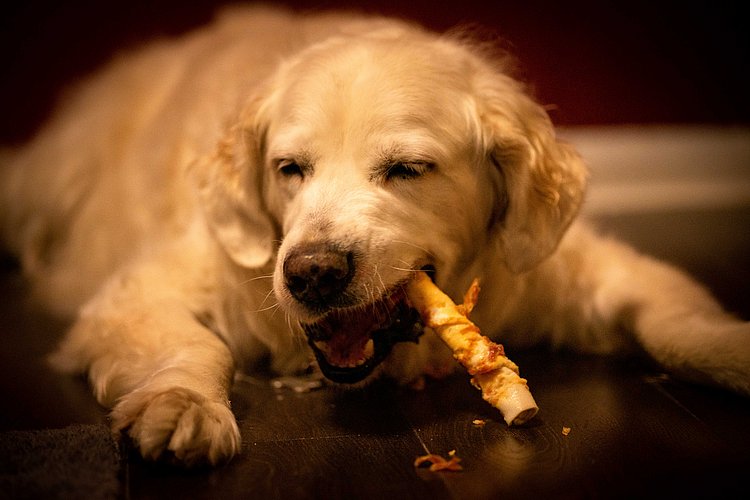Edible and versatile barrier layer for innovative animal feed products
Abstract
Heat-resistant, water- and gas-impermeable, mechanically resilient and edible barrier layer for the demarcation of differently moist areas in animal feed products.
Fields of application
The barrier layers described can be used in a variety of ways in all snack and feed products in which areas of different moisture content are to be permanently separated from one another, especially during heating, cooking, boiling, etc. during the manufacturing process or during storage. Possible applications are innovative products for pets as well as for farm animals, where (permanent) occupation by sucking off, nibbling or chewing is to be combined with a reward. Examples are filled chewing and sucking snacks for dogs and cats with a moist, inner filling (e.g. meat, yogurt, etc.) and an outer, dry shell (e.g. made of cookie, bread dough, oat flakes, etc.).
Background
Many feeds, especially snacks and "treats", consist of several different components that are characterized by different properties such as taste, consistency, or texture. The interaction of the individual areas plays an important role in sensory perception, taste, and ultimately the animal's acceptance of the product. An example of this is dog treats with a soft core of peanut butter surrounded by a cookie shell made from sweet potato or pea flour base.
Problem
For feed products with several components, the challenge is often to separate the different (moisture) areas as permanently as possible, especially during industrial production, transport and storage. The main challenge is to prevent moisture migration from the wetter areas to the drier areas, as many undesirable chemical and enzymatic reactions take place depending on the moisture content, which can lead to detrimental changes in the taste, color and texture of the product. Barrier layers to separate different areas within a product or to protect the product from the environment are already used in the food industry (e.g. in the form of hydrophobic, water-repellent barrier layers). However, such protective layers are often only suitable for a specific product and cannot be used universally.
Solution
At the University of Hohenheim, a universally applicable barrier layer was developed for use in the animal feed sector. The consumable protective layer is suitable as a water and moisture barrier and thus prevents moisture migration in feed and snack products. According to the invention, this is achieved by oleogels. These are fats that are structured by certain gelling agents. Some of these already have established applications in the food sector, for example in the substitution of animal fats with vegetable alternatives in sausage and meat products, or for reducing oil migration in cream fillings or chocolate, but not yet as a coating system. The composition of the oleogel is purely vegetable due to the use of vegetable oils (such as rapeseed, sunflower or olive oil) and ethyl cellulose. By changing the composition of the oleogel or by adding additives (such as flavoring or coloring agents), the oleogel layer can be optimally adapted to the specific application. In addition, the oleogel layers have a shelf life of weeks and can withstand heat and mechanical stress.
Advantages
- Impervious to water: very good separation of different moisture ranges
- Universally applicable
- Edible: bio-based from ethyl cellulose and vegetable oil
- Heat resistant: can withstand heating, cooking, simmering, etc.
- Flavor can be selectively adjusted by adding flavors
- Targeted adjustment of certain textures and elasticities
- Different application methods possible (e.g. glazing, spraying, etc.) thus integrable into different processes
- Different layer thicknesses possible

